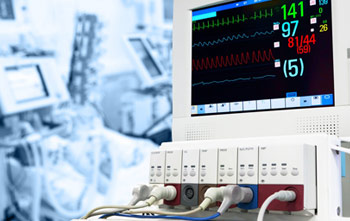Sign in or register for an account.

EKG Recognition
EKG monitoring is becoming more common in inpatient and outpatient care settings as well as emergency and critical care areas. Nurses and other healthcare professionals are responsible for cardiac patients including monitoring and interpreting cardiac dysrhythmias. They must develop critical thinking skills required to quickly and accurately identify potentially life threatening conditions. This course is designed for healthcare professionals wishing to enhance their level of education to include anatomy and physiology of the cardiac system, EKG electrode placement, equipment, and recognition of lethal and non-lethal dysrhythmias. A thorough understanding of the cardiac conduction system, circulatory system, lay out of the EKG waveforms to include the P-Wave, R-Wave, QRS Complex, T-Wave, as well as the PR Intervals, ST Segments, and the normal timings of each area is essential to EKG/ECG recognition and best patient outcomes. This course will also describe and discuss the different pacemakers, their uses, and troubleshooting techniques.
Questions? Check out our FAQs page and How Online IV Certification Works!
Objectives
Upon completion of this course, the participant will be able to:
- Explain what an EKG is and the importance of this diagnostic
- Identify the Skills needed to perform an ECG
- Identify and Recall the structures of the heart, its valves, and chambers
- Explain the Cardiac Cycle
- Identify and describe the components of the Conduction System
- Identify each part of the EKG Waveform
- Describe which conduction activity produces the EKG wave forms
- Identify the different leads
- Calculate patients HR using the EKG
- Identify the Anatomical Landmarks in the EKG process
- Identify artifact and the causes thereof
- Differentiate between an EKG and cardiac monitoring
- Explain the process of identifying the rhythm
- Identify the components of the rhythm
- Describe the process and criteria to determine a Dysrhythmia
- Identify the Normal Sinus Rhythm
- Identify the Sinus Bradycardia Rhythm
- Identify the Sinus Tachycardia Rhythm
- Identify the Sinus Dysrhythmia
- Identify the Sinus Arrest rhythm
- Describe the variety of Junctional Dysrhythmias
- Describe the variety of Supraventricular Tachycardia (SVT)
- Describe the variety of Heart Blocks
- Describe the variety of Ventricular Dysrhythmias
- Describe the variety of Pacemakers
Curriculum
Chapter 1: Basics of EKG
- The Electrocardiogram (ECG) aka EKG
- Other Conditions That Put Your Heart at Risk
- What is an ECG?
- Where to find an EKG Machine or Monitor?
- Hospital
- Doctors Office
- Elsewhere
- Anatomy and Physiology of the Heart
- Chambers and Valves
- Major Vessels
- The Circulation System
- Which Way Does Blood Travel?
- The Pump
- The Conduction System
- The Conduction Pathway
- The Waveforms
- Lead Placement
- Einthovens Triangle
- EKG Considerations
- Using EKG Paper
- How to Read?
- Calculating the Heart Rate
- Calculation Methods
- 6 Second method
- 300 Method
- 1500 Method
- Components of the EKG Rhythm
- Rhythm Interpretation
- Step 1: Determining Rhythm and Regularity
- Step 2: Determining Atrial and Ventricular Rate
- Step 3: Identifying the P Wave
- Step 4: Measuring the PR Interval
- Step 5: Measuring the QRS Duration
- Rhythms Originating in the Sino-atrial Node
- Sinus BradycardiaSinus Tachycardia
- Sinus Dysrhythmia
- Sinus Arrest
- Atrial Rhythms
- Premature Atrial Contraction
- Wandering Atrial Pacemaker
- Multifocal Atrial Tachycardia
- Atrial Flutter
- Atrial Fibrillation
- Junctional Dysrhythmias
- Premature Junctional Complex
- Junctional Escape Rhythm
- Accelerated Junctional Rhythm
- Junctional Tachycardia Rhythm
- Supraventricular Tachycardia
- Heart Blocks
- First Degree Atrioventricular Block
- Second Degree Type I
- Mobitz II, Type II
- Third Degree Heart Block
- Bundle Branch Block Dysrhythmias
- Rhythms Originating from the Ventricles
- Premature Ventricular Contractions (PVC)
- Idioventricular Rhythm
- Accelerated Idioventricular Rhythm
- Ventricular Tachycardia
- Ventricular Fibrillation
- Asystole
- Pacemakers
- Assessing the Pacer
- Pacemaker Complications
Chapter 6: References
- California Bill 241
- Implicit Bias in Healthcare
- What is Implicit Bias?
- Implications of Implicit Bias in Healthcare
- How to Reduce Implicit Bias
Price: $78.00
Contact Hours: 6.5

Course Author

Kevin Stansbury
Kevin Stansbury, MBA, BSN, BS, RN, CEN, VA-BC, is a Registered Nurse with over 25 years’ experience in the medical field including critical care, emergency medicine, and infusion therapy. He is currently living and working in the Central Valley of California. Kevin is a 13-year veteran of the U.S. Army where he served as a combat medic and nurse. He received several military decorations during his tours in Desert Shield and Desert Storm, including an Army Achievement Medal, an Army Commendation Medal, and the Kuwaiti Liberation Medal. Kevin also received his Expert Field Medical Badge while serving two tours in Korea.
Read Full BioCourse Accreditation
See our Accreditation Statements page to view our accreditation information.